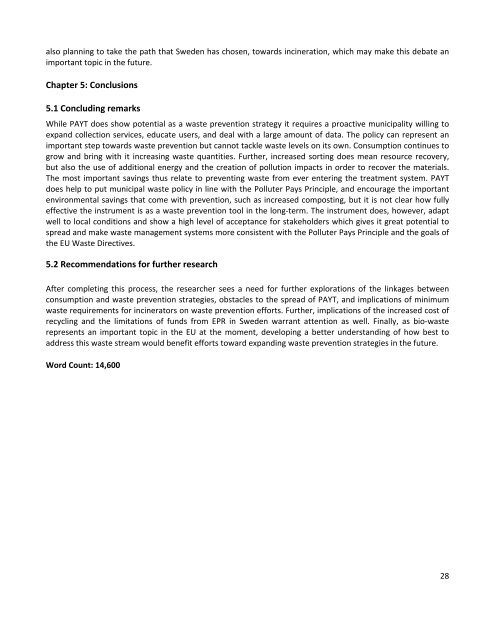Waste prevention and Pay as You Throw, a collective case ... - lumes
Waste prevention and Pay as You Throw, a collective case ... - lumes
Waste prevention and Pay as You Throw, a collective case ... - lumes
You also want an ePaper? Increase the reach of your titles
YUMPU automatically turns print PDFs into web optimized ePapers that Google loves.
also planning to take the path that Sweden h<strong>as</strong> chosen, towards incineration, which may make this debate an<br />
important topic in the future.<br />
Chapter 5: Conclusions<br />
5.1 Concluding remarks<br />
While PAYT does show potential <strong>as</strong> a w<strong>as</strong>te <strong>prevention</strong> strategy it requires a proactive municipality willing to<br />
exp<strong>and</strong> collection services, educate users, <strong>and</strong> deal with a large amount of data. The policy can represent an<br />
important step towards w<strong>as</strong>te <strong>prevention</strong> but cannot tackle w<strong>as</strong>te levels on its own. Consumption continues to<br />
grow <strong>and</strong> bring with it incre<strong>as</strong>ing w<strong>as</strong>te quantities. Further, incre<strong>as</strong>ed sorting does mean resource recovery,<br />
but also the use of additional energy <strong>and</strong> the creation of pollution impacts in order to recover the materials.<br />
The most important savings thus relate to preventing w<strong>as</strong>te from ever entering the treatment system. PAYT<br />
does help to put municipal w<strong>as</strong>te policy in line with the Polluter <strong>Pay</strong>s Principle, <strong>and</strong> encourage the important<br />
environmental savings that come with <strong>prevention</strong>, such <strong>as</strong> incre<strong>as</strong>ed composting, but it is not clear how fully<br />
effective the instrument is <strong>as</strong> a w<strong>as</strong>te <strong>prevention</strong> tool in the long‐term. The instrument does, however, adapt<br />
well to local conditions <strong>and</strong> show a high level of acceptance for stakeholders which gives it great potential to<br />
spread <strong>and</strong> make w<strong>as</strong>te management systems more consistent with the Polluter <strong>Pay</strong>s Principle <strong>and</strong> the goals of<br />
the EU <strong>W<strong>as</strong>te</strong> Directives.<br />
5.2 Recommendations for further research<br />
After completing this process, the researcher sees a need for further explorations of the linkages between<br />
consumption <strong>and</strong> w<strong>as</strong>te <strong>prevention</strong> strategies, obstacles to the spread of PAYT, <strong>and</strong> implications of minimum<br />
w<strong>as</strong>te requirements for incinerators on w<strong>as</strong>te <strong>prevention</strong> efforts. Further, implications of the incre<strong>as</strong>ed cost of<br />
recycling <strong>and</strong> the limitations of funds from EPR in Sweden warrant attention <strong>as</strong> well. Finally, <strong>as</strong> bio‐w<strong>as</strong>te<br />
represents an important topic in the EU at the moment, developing a better underst<strong>and</strong>ing of how best to<br />
address this w<strong>as</strong>te stream would benefit efforts toward exp<strong>and</strong>ing w<strong>as</strong>te <strong>prevention</strong> strategies in the future.<br />
Word Count: 14,600<br />
28
















